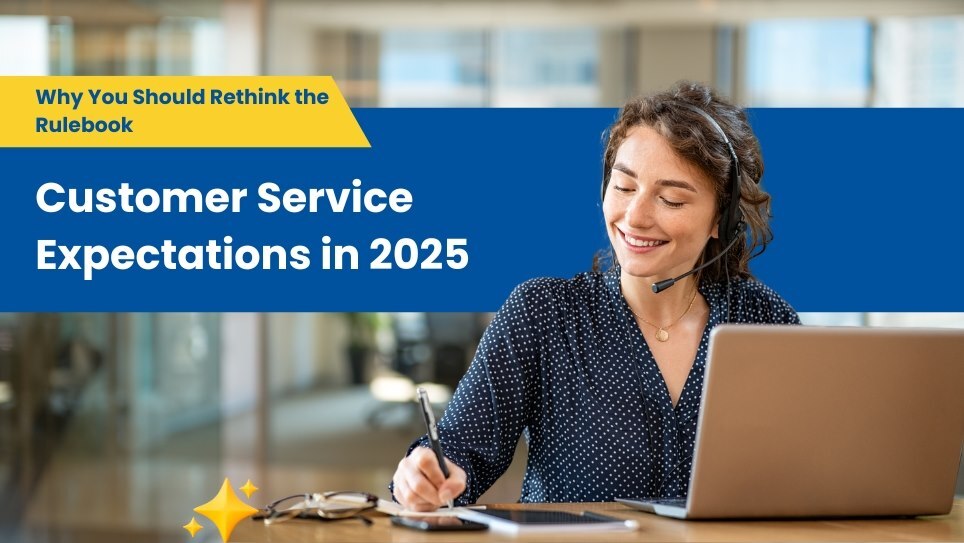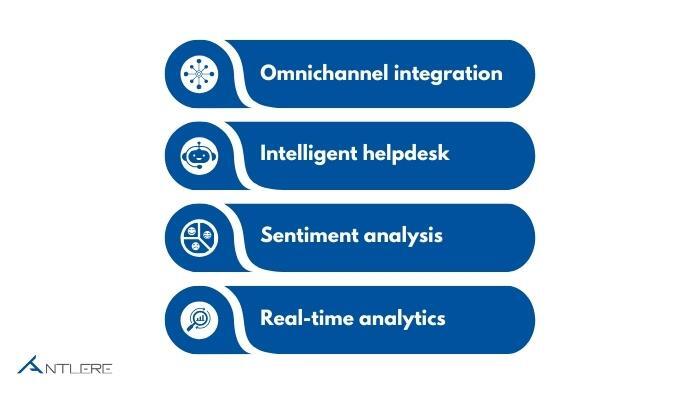

Customer Service Expectations in 2025: Why You Should Rethink the Rulebook
There was a time when it was acceptably a norm to wait half an hour or so to get your call answered by a customer support agent. Fast forward to today, and anything slower than a bot typing speed will land you a one-star review and likely a roast on social media.
This is the age of sky-high customer service expectations, where a company’s loyalty and perception are tied to how quick their response time is.
Customer service is never a one-size-fits-all. What counts as a “great service” now varies across generations. Millennials and Gen Zs, for instance, are two cohorts that have contrasting customer service expectations and wants.
Not keeping up with this wide spectrum of expectations would lead to missed opportunities in terms of elevating your retention rates and bottom line.
In this article, we will explore how customer service expectations have evolved over the years and across generations and what businesses must do to meet and exceed these expectations. And if you need a secret tool to stay at the top of this game, stick around for a smart and dynamic solution.
Then vs. Now: How Customer Service Expectations Have Evolved Over the Years
The Era of “Please Hold” (Pre-2010)
When we look back at the 90s and the early 2000s, customer service was majorly transactional. Phone lines were the primary medium of communication, email was a fresh concept, and self-service would mean digging out the required information from a product manual.
Customers would wait for hours and sometimes days to get their query answered or issue resolved. And a bonus would be a friendly agent who recalled their name and addressed them as “Sir/Madam.”
The 2025 reality shows a stark difference, though.
90% of customers expect an immediate response—within 10 minutes or less (HubSpot, 2024), and 71% expect personalized interactions (Salesforce, 2023).

Customers don’t just any service; they expect an instant, seamless, and emotionally intelligent
Customers are no longer looking for a service—they’re expecting a seamless, instant, and emotionally intelligent experience every time.
Millennials vs. Gen Z: A Generational Shift Redefining Customer Service Expectations
Not all customers are equal in terms of their service expectations. Although both millennials and Generation Z are digital natives, their customer experience expectations are contrasting; think TikTok vs. Netflix.
Understanding Millennials and Millennial Age Range
Millennials, also referred to as Generation Y, represent a demographic cohort following Generation X and preceding Generation Z. According to the Pew Research Center, the millennial age range is 1981–1996.
Millennials are the tech-savvy pragmatists who have lived through the smartphone revolution and dial-up internet. Although they are well-versed in the digital world, they have also experienced life before the advent of social media. They love tech but also appreciate a human touch to their customer experience.
Here’s what a millennial wants from their customer service:
Consistency – Whether it’s in-store or an app, millennials expect the same quality of service.
Omnichannel Experience – Millennials prefer options: calls, emails, socials, and chats.
Loyalty Rewards – 60% of millennials indicate a preference for brands that provide value-added services or reward systems.
Amazon is a fitting example of meeting millennial expectations. With easy chatbots, helpful returns, and elaborate order history, it’s a no-brainer why they are appealing to this demographic.
Understanding Gen Z And Gen Z Age Range
Gen Z is a demographic of digital natives that precedes Generation Alpha and follows millennials. Gen Zs don’t recall a time when there was no social media or smartphones. They’re accustomed to fast scrolling and staying hyper-connected and have minimal tolerance for any friction.
They grew up in the fast-paced digital world. Research suggests that this generation is highly driven, and more risk-oriented as opposed to the earlier generations.
Here’s what Gen Zs want from their customer service:
Self-Service—75% of the Gen Z population prefer solving issues on their own before reaching out for service or help.

Real-Time Service—A 5-minute or less response is the benchmark, not an exception.
Values and Authenticity— Gen Z cares what a brand stands for and how it communicates.
TLDR – While Millennials want convenience and connection, Gen Z appreciates control and promptness.
Glossier is one such example that perfectly caters to the Gen Z customer experience expectations. It is a community-driven, chat-based brand that deeply resonates with Generation Z.
How Can We Explain These High Customer Service Expectations
Fact alert: it’s not just a generational contrast but a cultural transition defined by psychology, competition, and, most importantly, tech.
Social Media Upsurge
Today, a single Instagram Reel, TikTok video, or viral tweet can compromise a brand’s name. The Gen Z customer is aware of the power they hold. You are not just serving them but also their audience.
The Amazon Effect
With stellar 24/7 support, prompt deliveries, and hassle-free returns, Amazon is setting a service benchmark that everyone is persuaded to follow in the footsteps.
Prioritizing Emotional Intelligence
A Harvard Business Review suggests that customers with an emotional connection are 52% more valuable to a business. Gen Z customers expect agents, whether human or AI, to consider their preferences, moods, and pain points.
Must-Haves Every 2025 Business Should Deliver
Accuracy & Speed
Whether it’s a live agent or a chatbot, customers demand solutions, not to be put on an endless hold music or apologies.
Hyper-Personalization
Utilize the fact that you have access to in-depth data stores on customer needs and preferences. You can refer to them by their name, quote their purchase history, and make tailored recommendations.
Omnichannel Support
No one wants a scattered service. Your email support, web chats, and social media should all be connected and unified.
Proactive Service
One way to meet the evolving customer service expectations is to reach out before there is a complaint. Simply saying, “Hi, we just saw your subscription is close to expiration; do you need help with the renewal?” can work greatly in your favor.
Empathetic Communication
Today’s customer does not appreciate a scripted or robotic response. Messages created with authenticity and emotional intelligence foster loyalty and trust.
Get The Antlere Advantage: Reimagine A Modern Age Customer Support
You’re probably wondering how to implement all that you’ve learned so far. That’s when we introduce you to Antlere Customer Experience Platform – A powerhouse built for businesses wanting to keep up with skyrocketing customer service expectations and stay ahead of the latest advancements in the service world.
What Do You Get with Antlere?
- Omnichannel integration across social media, chat, email, and more.
- Intelligent helpdesk with smart routing and AI-driven communication.
- Sentiment analysis to understand customers’ moods and respond accordingly.
- Real-time analytics to get insights into employee performance and customer satisfaction.
Whether you are serving a Gen Z population looking for prompt, emoji-loaded support or a Millennial group expecting a polite and authentic follow-up, Antlere shows up with assistance where it’s needed, when it’s needed.

Final Thoughts
In 2025, customer service is not just about beating your competitors but about revamping your own brand image every passing day.
With evolving customer service expectations comes a need for a revised and improved strategy. The businesses that are winning are those that observe, listen, adapt, and take the actions required to stay ahead.
Ready to get up to speed with modern customer expectations?
Equip your team with Antlere— where outstanding customer service gets an effortless execution Explore Antlere CXM today.

Frequently asked questions
What is the difference in communication across generations?
Millennials and Gen Z prefer real-time communication like DMs and live chats, while Boomers and Gen X are more drawn to phone support and email. Creating tailored communication channels catering to specific generational preferences can majorly improve satisfaction.
What impact does social media have on customer service expectations today?
Now that we have social commerce, customers expect businesses to resolve issues directly via platforms like Instagram, X (formerly known as Twitter), and TikTok. It is not just confined to marketing; social media essentially serves as a frontline help desk now.
Do the younger generations care about loyalty programs?
They do, but only if they are digital and customized. Conventional punch cards are not very relevant anymore. Generation Z.
How can companies train their teams to meet the advanced customer service expectations?
Consistent training in digital fluency, empathy, and cross-generational communication is incredibly important. Understanding how generations differ in behavior helps employees deliver relevant and smarter support.
Why are industries facing a prominent shift in customer service expectations?
Fintech, healthcare, and retail are at the forefront. With Gen Zs penetrating the marketplace and workforce, businesses must make relevant and smart changes to meet their high-speed, digital-first expectations.



